Right hand tone production :
Techniques and more on Tonus and Détaché
( From an email lesson / The student
kindly consented to having this page published )
The
student sends in some questions about this lesson
The student sent in a .wav file ( a brief recording of his étude ) : The
best time to send this ( 1 MB in file size ) is on weekends ( Saturday and
Sunday ) only, as there are cheaper connection rates on those days.
This essay constitutes my hardest attempt at
describing and expressing the most intricate and complex mechanism of all
violin playing : the generation of a singing tone. About the détaché study
n.1 : The notes themselves present no problem to you as far as understanding
and reading goes , but your needs are on a completely different aspect. As
you rightly hint, the right arm needs to be developed, and refined before
achieving a sound of superior quality, and this is why, though the studies
appear straight forward from an intellectual point of view, they still need
working on. Therefore it is important you follow my instructions as closely
as possible, making no deviations nor taking liberties of your own ( for the
moment ! )

Firstly : Practice this etude playing each note twice. i.e..
a down and an up bow for each note. Confine the bow exactly to the middle, using
about 40 - 50 % of the bow length, almost entirely with the forearm. Practice
very slowly ( quarter note = 60 MM ) . So you play two eighth notes in a
metronome beat. All your right hand apparatus ( which includes wrist, knuckles,
forearm and fingers and bow contact point and weight and speed ) should be
assembled and controlled at this speed. Only after a correct and accurate
functioning of the right arm should you step the tempo up to 70 and later 80+.
About the bowing in more detail : Your contact point should
be half way between bridge and fingerboard. Your weight on the string is far too
high ; you need a much lighter bow : about 35% of your present pressure. In
order to activate and stimulate the right hand in producing a beautiful singing
tone, you must use it more than the left ( which is why the note is played twice
and played slowly ). Also what must be present is a correct wrist adherence
action, which you will soon discover is very much connected with the forearm and
hand in producing adherence. The string is set in vibration through an adherence
or friction of the bow on the strings. Your right hand arm and hand must
generate a "friction" mechanism within itself. At the moment there is
a faulty and excessive friction caused by too much bow weight ( which harms the
A and E string tone more noticeably than the D and G string tones ). At the
moment using more bow would apparently help this, but only momentarily. It is
important you confine the bow to the middle portion only, yet search for and
subsequently find a healthy dosage of both weight and wrist-generated friction.
Right hand components : The exactness and precision of the
right hand mechanism is easy to illustrate but very hard to describe in words.
But this is an attempt : The 3 components in détaché are forearm / hand /
fingers. all 3 must be active accumulating sound, and conscious of the
continuous feeling of friction. On the down bow : the thumb and first 2 fingers
bend, while the knuckles flatten, and the wrist lowers, as the forearm travels.
All these movements occur simultaneously in a tiny ( almost imperceptible )
quantity, but exactly the quantity needed to produce the required friction for a
positive tone. Presently your pressure is excessive because one of these
components is locked / blocked, and an insensitive and damaging friction is
being produced. The problem is twofold in that we need the right type of
friction - and we need to diminish the amount of friction. We need to diminish
to improve the freedom of string vibrations, though we still need to talk about,
and clarify this term friction, because it IS that very word ( friction ) which
is the key to the whole problem of tone production.
To return to our right hand mechanism : the intricacy of the
movements has been touched upon, and this collection, and fusion of movements
must be performed with a slight reluctance or resistance throughout the
movement. This reluctance of the muscles and hand to shape itself into a
collected or closed shape is the very same feeling and mechanism as the friction
of bow on string. The connection between the bow / string friction, and the hand
/ arm friction must be so close as to feel one and the same phenomena. Soon, as
this friction is incorporated into the détaché stroke, it will become apparent
that it is possible to vary the exact dosage and concentration of friction (
translate sound or tone ! ). Therefore "sound" is in the right hand.
Having acquired a healthy and positive tone gathering mechanism in the right
hand , one feels a tremendous magical sense of power and possessiveness in the
hand. For all the left hand techniques and tricks violin playing and sound
generation will always depend on the deftness and experience of the right hand.
Working together : In a right hand all the muscles and
components of the arm must be functioning in a healthy and positive way. The
various components must all function independently of each other, yet in
conjunction, adding their combined power of friction, or sound accumulation
together. The first 3 fingers ( thumb + 1 & 2 ) curling and grouping is
called finger-flex. The opposite on the up bow is a GRADUAL straightening or
releasing of tension in the fingers. This too is a reluctant movement, which
produces friction due to this slow release. The hand lowering ( which also
contains a horizontal wrist component ) is called wrist-bending ( the wrist is
none other than the angle produced between hand and forearm ). Now the wrist is
remarkable in that it can flex or bend both horizontally and vertically, and in
any combination of the two. It is a very versatile joint ! The action involved
in violin playing involves both directions, hardly ever just a pore movement in
the one direction. The 3rd component is called forearm movement, and is produced
by the movement of the forearm, pivoted on a stationary elbow, and moving thanks
to the wrist-bending discussed earlier.
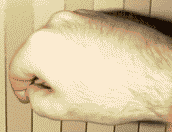
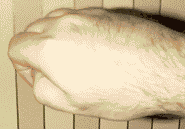
Above : Finger-flex : The left photo has
slightly elongated fingers and thumb and the knuckles protrude slightly : Note
very carefully how in the right photo the thumb and fingers are slightly more
curved - they have therefore accumulated sound during the down bow - Below
another view from the side of the photo on the right. Note how the knuckles
are flatter, and the thumb is closer to the base of the first finger.
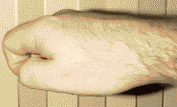
My experience in Practice : Now the fine-tuning of all these
components is the job of a great teacher who has knowledge of the St. Petersburg
school. Other Russian schools may also develop and deal with this aspect, but
not all will deal with it in the same way. The Moscow school promotes a more
generous, broader forearm, while the St. Petersburg favours a more concentrated alla
corda. The quantity of bow used in détaché in comparing both schools is
almost extreme. Now, should you start worrying about losing out on this
incredibly important "heart" of violin playing, let me point out that
the VAST majority of teachers never ever touch upon this subject. Most will
appreciate that a superior style of détaché can be learned, and one comes
across several pupils who have obviously been through détaché coaching, (
sometimes early on in their learning ) , but few teachers have the time, energy,
will, patience, pay, talented child, or even the knowledge to be able to set-up
and refine a pupils' détaché. My encounter and mastery in the first stage of détaché
took 6 months of two 6 hour lessons a week. One lesson I would come back only to
have exaggerated the wrist bending - then the teacher would tell me to reduce
the wrist action, but maybe use more finger action. Each lesson the teacher
would shape and mould my bowing like a sculptor, and I would go away sometimes
having deviated quite a lot from the original intentions of the teacher.
Sometimes the more I practised, the more I would deviate from the prescribed
indications.
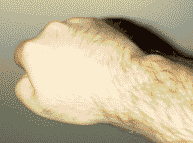
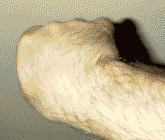
Above : The wrist has much versatility
in movement : Here is illustrated just the horizontal flexibility , and the
picture on the right shows how the wrist can bend , leaving the inner wrist
pointing at our nose. This is important when approaching the heel, and indeed
when playing at the heel
Even bowing : The material for studying and applying détaché
is études. détaché involves two notes : one down the other up. Both must be
of identical sonority and adherence. It is common to accumulate and hold the
sound better and more substantially on the down bow than on the up bow. In other
words, détaché is usually erroneously played with an accented down and a weak
up bow. The length of the up bow, and the attention to string adherence must be
increased, therefore, on the up bow.
Common errors : There are many common errors when playing détaché
: playing at the tip, with an elbow which follows the bow, and moves in tandem
is a terrible defect. This causes the forearm not to open out, and the elbow (
the angle between forearm and upper arm ) stays at a right angle. Obviously this
looks, and is, rigid ! Another problem is usually some locking of the thumb. The
thumb must never be applied to the stick insensitively in a straight angle : it
must always be bent, and always in motion, adhering to the stick with some
degree of bend. The thumb has a vital role ( together with the first 2 fingers )
in accumulating détaché. The 3rd and 4th fingers are best left almost passive,
as they have more important roles during chords and heel playing. Détaché may
be practised with these last 2 fingers off the stick, though leaving them on has
its advantages. Other errors consist in using too much wrist movement : the
so-called floppy wrist. If your wrist action is noticeable, then it is probably
too much. The amount of wrist bending should be directly proportional to the
amount of bow used, and the amount of sound collected. If too must wrist bending
occurs then the adherence of the bow is lost, through an excessive and an
undesired disturbing movement. Do not flap your wrist.
A flat bowing arm : Another important concept, particular to
détaché is the placing of the elbow. The height of the elbow must be neither
too low nor too high. Indeed it all depends on which string we are playing, but
it has been said that the correct height ( vertical height ) of the elbow is
attained when the best, and most easily generated quality sound occurs on that
given string. Indeed the whole arm would appear quite flat, on the same
horizontal plane, when bowing on the D string. The wrist must not stick up (
especially at the heel ). The elbow must not stick up, nor the shoulders.
Neither should the hand stick up ( caused by a very low elbow ). The whole arm (
including hand and wrist ) should be on a flat, horizontal plane when bowing on
the G or D string. When bowing on the G string it is important to incline the
violin in such a way, so that the inclination is increased, and the G string is
placed in a more comfortable position, closer to the right hand. On the A and E
strings the violin may be flattened, therefore avoiding a vertical bow stroke,
but maintaining a horizontal one. This flat position allows for a vertical
contribution of gravity and bow weight ( important during Spiccato ).
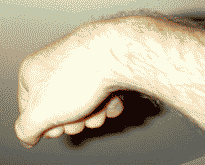
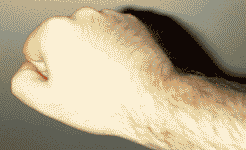
Above : The wrist bends vertically. This
quantity of bend has been exaggerated to make the movement clear. In practice
only a very small fraction of this movement is used. On the left we have a
reserve of sound, which is gradually expended by moving the wrist into the
string, during the down bow, in order to adhere. At the end of the down bow
one would end up with a lower wrist ( as on the photo on the right ). Please
note this photo has greatly magnified the amount of bend one would use in
practice. Also, it is sometimes very sensible never to expend all the vertical
height, in order to have available an extra dosage of "string adhering
mechanism" should it be needed. The photo on the left is the equivalent
of having your lungs filled with air.
Flexibility : Eventually I plan to expand and illustrate
this article with pictures. A movie file would be just great - ( though I don't
know how to do that ! ) Right now, even though the attainment and mastery of
this delicate and enormous subject seems impossible, it seems imperative that
you lighten the bowing, and lighten the bow grip especially for this purpose. If
you notice your fingers immobile, keeping the same shape throughout a détaché
( 1 note ) stroke, then they are locked. In this case your right hand will look
like porcelain, and not like some moldable and flexible fleshy hand. If your
right hand is fixed in this way, you need to work on altering its shape in a
flexible and "melting" manner. If your wrist is not bending at each
stroke, then there is another locked component. If you are using your upper arm,
then the elbow is not opening and closing, and if you tire after 5 lines then
you are also using your right arm in an incorrect and unbalanced way.
A slow change : This technique for sound generation is
something that is perfected and improved gradually. Aches and pains sometimes
mean the wrist is being used for the first time, but the correct tension and
pliability of the muscles will ensure a healthy and enduring détaché
mechanism. A combination of knowledge and observing a demonstration of this
right hand technology will eventually lead to greater understanding and mastery
of this delicate subject. If muscles are not used well they will rebel and ache.
Sound will become hard, brittle, and muddy.
Focus your energy : There can be little doubt that right
hand technique such as what has been described above makes all the difference in
quality between a good and a bad player. Certainly there are many people that
struggle, force and contort their muscles through determination and stubbornness
to reach the end of the etude, but this rarely is comfortable and pleasing for
both performer and listener. The attainment of a superior quality sound goes far
beyond the simple study of the notes, or the understanding of which fingering to
apply. The correct and successful conjuring of a good tone involves channeling
and focusing one's energy and "tension" ( for there is no such thing
as NO tension in playing - otherwise we would all be lying down on the floor ! )
into sound. Much energy of the bow on the string is lost as heat, and even more
energy is lost in negative, or useless tension.
High quality sound : I hope to have enlightened readers on
this little understood and underestimated subject. But I fear that an
understanding is neither easy nor readily attainable in a short time. Complete
mastery of détaché is still somewhat more complex than the summary outlined
here, and it has to be done in the flesh. However I would state that the
information an insight contained in the above essay does exceed the efforts and
understanding of the "average" violin, viola, or cello teacher. Some
things like the point of bow on string contact have not been completely
explained : the weightier and slower bowings are best played near the bridge,
while fast, light strokes would not adhere at the bridge, only close to the
fingerboard. The 3 external objective) elements that make up tone are bow speed
( s ), weight or pressure ( w ) and point of contact ( p ). Combinations of s, w
and p are many and varied, but their "internal" equivalents on how the
muscles feel and perceive them have almost never been described in violin
literature. Oddly, Piano literature deals with the external elements, and to a
lesser degree internal elements more thoroughly than violin literature. There
are many differing schools on this internal aspect, but the end result is always
the production of extremely high quality sound. One may easily judge the quality
of a soloist by their tone. A pianist will caress and conjure a singing phrase -
a violinist will have a small velvety and rounded even tone. Pianists who have
sharp, percussive, and jerky, abrupt chords are lacking in touch and warmth.
Comparing bowing to a wind instrument : The production of
tone in string playing can be likened to the blowing of a trumpet. A steady flow
of air must be constantly dosage. The flow must be controlled and even in
pressure. A clever way of gaining insight into the production of tone is to
listen to great Russian Sopranos. Where the sound and tension is and isn't
applied, during their melodious arias gives musical insight in how to and when
it is beautiful to apply more or less pressure or concentration of sound. The
ultimate goal is to produce a spectacularly flowing phrase which leads us into
listening to something which speaks and communicates direction, and
expressiveness. A détaché study is not made up of equal notes to be played
like a machine gun. Phrases finished and must be tapered off, and phrases build
and lead forward, meaning that a constant application of tension and control in
volume is necessary to bring out the natural shape of the phrase.
Sustain the notes : Lastly it must be understood that a note
must be played ( sung ) throughout its duration. Unlike a pianoforte, we have to
"hold" ( or sing ) a note for it's entire duration. The connecting of
successive notes, and the soldering of sound during a down bow and its
successive up bow are vital in a good détaché. The result should be a
continuous flowing of sound. Always practice some right hand on an open D
string. Try to produce 5 détaché notes which sound so similar to a single note
held for that length of time. A passage played with good détaché should sound
as if it has been played legato : all the notes perfectly joined together - no
gaps in between, to produce a "lake" of constant sound.
Yet to be explained : Thumb movements and finger movements -
These naturally extend and straighten out as we near the tip of the bow ( if one
were to produce a hollow, frictionless and not concentrated or watery sound ) -
however, the resistance "rule" compels us to nullify this tendency,
almost bending the fingers instead. The sensation is of bending, but I cannot
tell if the fingers are bending or straightening out on the down bow. I suspect
they are extending on the down, but my sensation of retaining and holding the
sound makes me feel I am opposing ( therefore bending ) this movement. The
important point to remember is that these are sensations / and are not 100% accurate
from an objective point of view. Also, if one were to measure all the forces
exerted objectively, with scientific instruments, one would have accurate
measurements , but no inward feel of the sensations and feelings involved. (
which are somewhat more colourful and passionate. ) Finally, I therefore
guarantee my principles ( not mine actually - the St.Petersburg school's and Mr.
M.Vaimann's ! ) from a subjective point of view, even though objectively one
could conveivably fault the description or quantification of a movement. (
THOUGH I DOUBT IT !! ). Any mistakes or misleading descriptions in this essay
will be modified and clarified according to feedback.